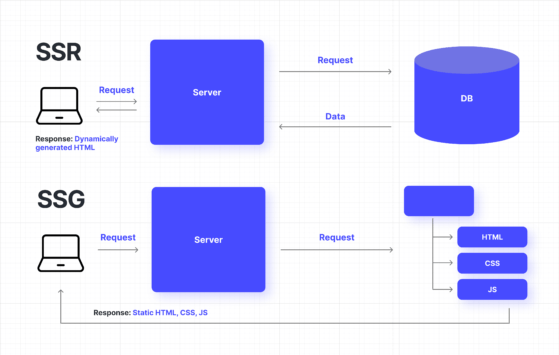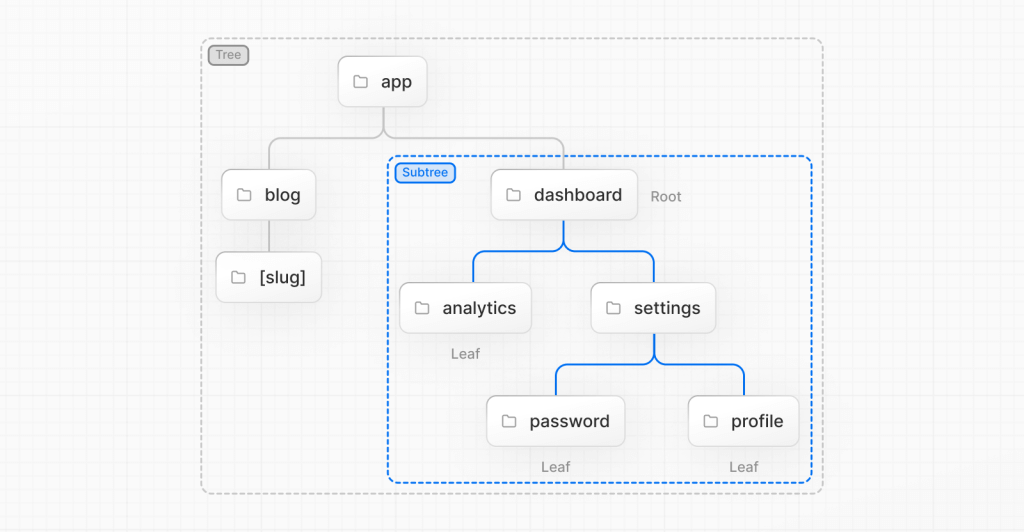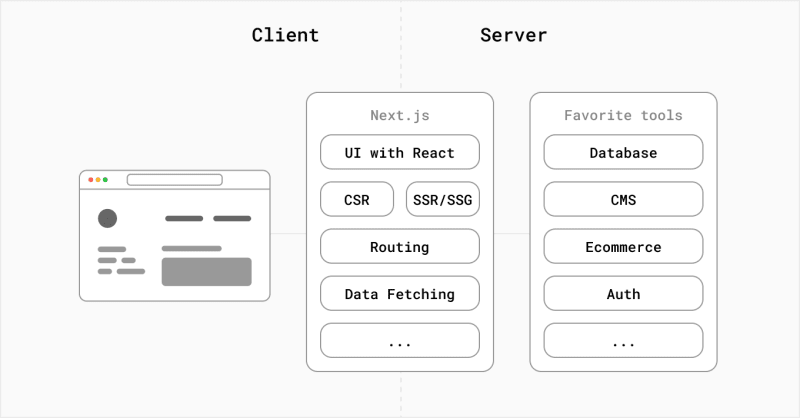Next.js is a React framework for building high-performance websites and web applications. It's popular because it makes development faster and easier.

Next.js handles server-side rendering, static site generation, and code splitting out of the box. This improves load times and user experience. It also has built-in support for modern web standards like ES6, CSS modules, and static exports.
With Next.js, developers can create fast, secure, and scalable web projects quickly. Many top companies like Netflix, Uber, and Twitch use Next.js for their websites and apps. If you want to build a high-quality website efficiently, Next.js is an excellent choice.
Introduction To Next.js
Next.js is a popular open-source React framework developed by Vercel (formerly Zeit) that simplifies the process of building modern, high-performance web applications and websites. It is built on top of React, a widely used JavaScript library for creating user interfaces.
Create Amazing Websites
With the best free page builder Elementor
Start NowAt its core, Next.js provides a way to render React applications on the server-side, rather than just on the client side (in the user's browser). This server-side rendering (SSR) approach has several benefits:
- Faster Initial Load Times: When a user visits a Next.js website, they receive a fully rendered HTML page from the server, which loads almost instantly. This contrasts with traditional client-side rendered React apps, where the user initially sees a blank page while the JavaScript code loads and renders the content.
- Better Search Engine Optimization (SEO): Search engines can easily crawl and index server-rendered pages, leading to improved SEO performance.
- Improved User Experience: With server-side rendering, users don't have to wait for the JavaScript to load before seeing the content, resulting in a smoother and more responsive experience.
Benefit Of Using Next.js
Let's now discuss some of the unique features that Next.js offers in more detail.
Server-Side Rendering (SSR)
Server-side rendering (SSR) in Next.js refers to the process of generating the HTML for a webpage on the server side, before sending it to the client's browser.

In SSR, when a user requests a webpage, the server executes the necessary code to render the page and then sends the fully rendered HTML to the browser. This allows for faster initial page loads and ensures that search engines and social media crawlers can easily index the content of the website.
Next.js supports SSR out of the box, making it easy for developers to create React applications that render on the server side. With Next.js, developers can build dynamic web applications that benefit from the performance advantages of SSR while still leveraging the power and flexibility of React for client-side interactivity.
Static Site Generation (SSG)
Static Site Generation (SSG) in Next.js refers to the process of re-building a website during the build time rather than generating it on each request.

In traditional server-side rendering (SSR), the server dynamically generates the HTML for each request. However, with SSG, Next.js generates the HTML for all the pages at the time of build based on the data available at that time.
This pre-built HTML is then served to the client upon request, which can significantly improve performance as there's no need to generate the page content on the fly for each request. SSG is particularly useful for content-heavy websites where the content doesn't change frequently.
Next.js provides support for SSG through its getStaticProps and getStaticPaths functions. These functions allow you to fetch data at build time and pre-render pages with that data. When a user accesses the site, they receive the pre-generated HTML, resulting in faster page loads and improved SEO performance.
Routing
In Next.js, routing refers to the mechanism by which the application navigates between different pages or views based on the URL. Next.js uses a file-based routing system, meaning that each page in your application corresponds to a file within the pages directory.

When a user requests a specific URL, Next.js matches that URL to the appropriate page file and renders the content of that file. This approach simplifies the process of creating routes, as you only need to create new files within the pages directory and Next.js takes care of the routing automatically.
Additionally, Next.js provides features like dynamic routing, which allows for the creation of routes with parameters that can change based on the URL. This is useful for building dynamic content or handling different data based on user input.
Overall, routing in Next.js is a fundamental aspect of building single-page applications, allowing developers to create navigable and structured user experiences seamlessly.
Automatic code splitting
Automatic code splitting in Next.js refers to the process of breaking down a JavaScript bundle into smaller, more manageable chunks automatically. This technique helps improve the performance of web applications by reducing the initial load time and only loading the code that is necessary for the current page or route.

Next.js employs a feature called "Automatic code splitting" by default. When you create a Next.js application, it automatically splits your code into separate bundles based on the pages or components of your application. Then, when a user navigates to a specific page, only the JavaScript required for that page is loaded, rather than loading the entire application bundle.
This approach ensures that users receive a faster initial page load experience because they're not downloading unnecessary JavaScript code. Additionally, as users navigate through the application, only the code needed for each subsequent page is fetched, further optimizing performance.
Overall, automatic code splitting in Next.js is a valuable feature for developers as it simplifies the optimization process and helps create faster and more efficient web applications.
Hot Reloading
Hot reloading in Next.js refers to the process of automatically refreshing a web page when changes are made to the codebase during development.
When you're working on a Next.js project and you modify your code (such as components, styles, or data fetching logic), the development server detects those changes and automatically updates the running application in the browser without requiring a manual refresh. This allows developers to see their changes instantly, speeding up the development process and enhancing productivity.
SEO Capabilities
Next.js offers a significant advantage for projects through its SEO capabilities. SEO, crucial for branding, can be effectively optimized using Next.js.
Google's web crawlers prioritize quick, secure, and informative pages. Next.js developed pages inherently possess these traits, making them easier for search engines to index. This enhances brand visibility and discoverability.
Numerous companies have reported notable enhancements in SEO rankings and website traffic upon adopting Next.js. For example, Netflix witnessed improved organic search traffic and increased user acquisition post-Next.js implementation. Similarly, Airbnb experienced a substantial surge in marketing metrics and website traffic after integrating Next.js.
These case studies and success stories underscore Next.js's SEO-friendly attributes, which undoubtedly elevate search engine rankings.
User Experience
User experience (UX) significantly impacts the success or failure of digital businesses. Neglecting UX can lead to losing customers, abandoned carts, and a high bounce rate, particularly evident in online shops.
The design also plays a crucial role. Using themes or templates often results in a generic appearance, hindering the creation of a unique customer experience. However, with Next.js, developers can craft fully customized user experiences.

Here's how:
- UX Freedom: Next.js empowers developers to bypass the limitations imposed by plugins, templates, or CMS platforms. Its flexible file-system routing and support for CSS-in-JS libraries enable extensive frontend customization.
- Adaptability and Responsiveness: Next.js offers features like automatic image optimization and responsive loading, allowing developers to create web applications adaptable to various screen sizes. Integration with modern CSS frameworks further enhances responsiveness.
- Short Page Load Time: Leveraging Next.js's static site generation (SSG) and incremental static regeneration (ISR) capabilities significantly reduces page load times. Pre-rendered pages are served to users, decreasing the time to the first byte (TTFB) and enhancing overall site speed.
- Data Security: Next.js strengthens data security for static websites by minimizing direct database connections. This reduces exposure to vulnerabilities, enhancing site security.
These features collectively contribute to an exceptional user experience. And the advantages of Next.js extend beyond these benefits.
Wrapping Up
Next.js is a top-notch framework that streamlines the development of high-quality websites and web apps. It offers a range of powerful features that provide numerous benefits.
With server-side rendering and static site generation, your project will load swiftly, reducing costs and boosting search engine visibility. The routing capabilities are flexible and user-friendly, allowing seamless navigation. Code splitting optimizes performance automatically, while hot reloading enhances productivity during development.
Overall, Next.js simplifies the creation process while delivering exceptional results, making it an outstanding choice for your upcoming project.





